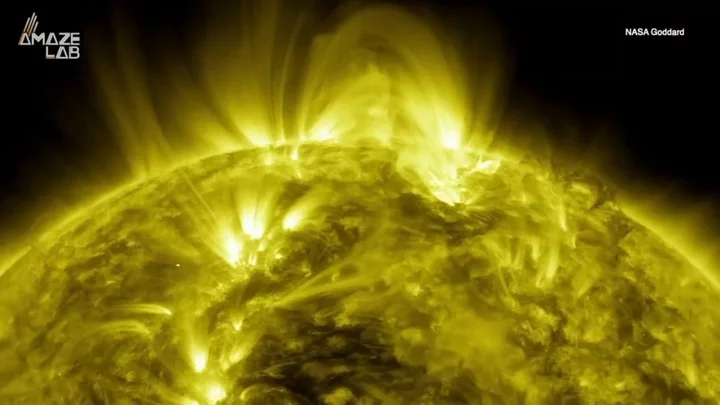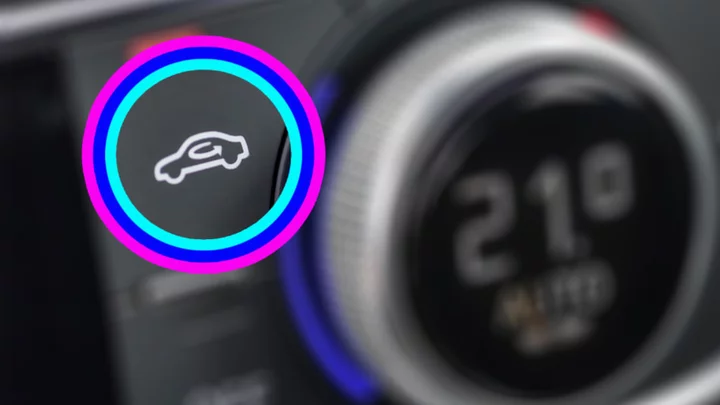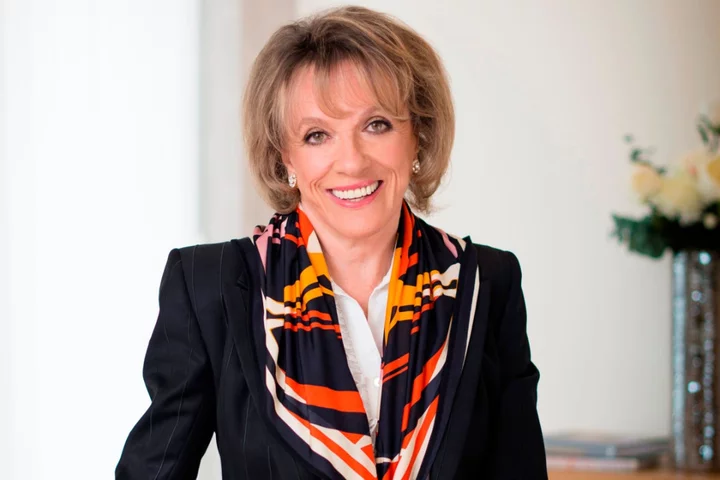
Thailand media guide
An overview of the media in Thailand, including links to broadcasters and newspapers.
2023-05-26 23:56

‘Monster stars’ 10,000 times bigger than the Sun detected for first time
Scientists have been peering into the depths of space, looking right back at the early days of the universe, and they’ve found something very interesting indeed. Researchers using the James Webb Space Telescope have come across a discovery that indicates some of the very earliest stars to ever form in the universe were staggering in scale, measuring 10,000 times bigger than the Sun. "Today, thanks to the data collected by the James-Webb Space Telescope, we believe we have found a first clue of the presence of these extraordinary stars," says astrophysicist Corinne Charbonnel of the University of Geneva in Switzerland, in research published in Astronomy & Astrophysics. These features are huge collections of between 100,000 and 1 million stars known as globular clusters, which all feature similar properties. Scientists estimate that they were all formed at the same time. Sign up to our free Indy100 weekly newsletter They’re remnants of the ancient universe and have been described by researchers as "fossils". The cores of these stars are much hotter than those we see in stars today, and scientists suggest it could be down to an excess of hydrogen burning at high temperatures. It’s thought that smaller stars collided with the supermassive stars and relished their energy. However, now most of these global clusters are approaching the very end of their life spans. "Globular clusters are between 10 and 13 billion years old, whereas the maximum lifespan of superstars is two million years," said Mark Gieles, previously at the University of Surrey but now at the University of Barcelona, back in 2018. "They therefore disappeared very early from the clusters that are currently observable. Only indirect traces remain." The researcher states: "If the supermassive star scenario can be firmed up by future studies, this would provide an important step for our understanding of globular clusters and for the formation of supermassive stars in general, with numerous important implications.” Have your say in our news democracy. Click the upvote icon at the top of the page to help raise this article through the indy100 rankings.
2023-05-26 23:26

Crash of private Japanese moon lander blamed on software, last-minute location switch
A Tokyo company whose lunar lander slammed into the moon says a software issue and a last-minute switch in the touchdown location led to the crash
2023-05-26 23:20

Pope Francis pulls out of Friday audiences because of fever
The 86-year-old Pontiff cleared his morning schedule because of a fever, a Vatican spokesman has said.
2023-05-26 22:21

Celine Dion cancels entire tour due to health issues
Celine Dion's "Courage World Tour" dates through 2024 have been canceled as she continues to battle a rare neurological disorder, it was announced Friday.
2023-05-26 21:50

What Your Car’s Air Recirculation Button Does—And Why You Should Be Using It
Your car’s air recirculation button can make life easier on you and your air conditioner.
2023-05-26 21:17

Discovery of '2000-year-old computer' leaves scientists baffled
Scientists have been left baffled by the discovery of the wreck of a 2,000-year-old “computer” that is amazingly complex. The Antikythera mechanism – an astronomical calendar – has been dubbed “‘the first computer” and has baffled scientists for generations after it was first discovered inside a Greek shipwreck in 1901. The device is a hand-powered time-keeping instrument that used a wing-up system to track the sun, moon and planets’ celestial time. It also worked as a calendar, tracking the phases of the Moon and the timing of eclipses. Despite sounding relatively simple, the mechanism was actually ahead of its time, being more technically sophisticated than any other tool that was invented over the next 1,000 years. In its current condition, the mechanism is in 82 separate fragments with only a third of its original structure remaining, including 30 corroded bronze gearwheels. Sign up to our free Indy100 weekly newsletter Research into the device from experts at University College London involved 3D computer modelling and helped them solve the mystery of how the device worked, revealing a “creation of genius”. Adam Wojcik, a materials scientist at UCL said at the time: “We believe that our reconstruction fits all the evidence that scientists have gleaned from the extant remains to date.” They theorised that the device tracked the movement of the sun, moon and planets on concentric rings, as the ancient Greeks believed that the sun and planets revolved around Earth, rather than the sun. The researchers explained in Scientific Reports: “Solving this complex 3D puzzle reveals a creation of genius—combining cycles from Babylonian astronomy, mathematics from Plato’s Academy and ancient Greek astronomical theories.” Have your say in our news democracy. Click the upvote icon at the top of the page to help raise this article through the indy100 rankings.
2023-05-26 20:52

Bank holiday heatwaves predicted: 6 sunburn myths that could put you at risk
After a largely disappointing spring, the bank holiday weekend is set to bring with it the warmest weather of the year so far. Temperatures are predicted to go as high as 24C on Saturday and Sunday, according to the Met Office, with dry and sunny weather expected to last into next week. Many of us will be heading out to enjoy the sunshine – but as ever, it’s important to protect your skin from harmful UV rays. When it comes to tanning and sunburn, there are a variety of misconceptions that still abound, and the consequences of not following sun protection advice can be severe – especially as skin cancer rates across the UK have been rising, charities have warned. Here are five sunburn myths that could be putting your health at risk… 1. The UK and Irish sun isn’t strong enough for sunburn We might grumble about the gloomy weather in our part of the world, but the risk of sunburn remains for a large part of the year. “The sun can be strong enough in the UK between mid-March and mid-October to burn you,” says Karis Betts, senior health information manager at Cancer Research UK, which is working in partnership with Nivea Sun to educate consumers on how to be sun safe. “You’re most likely to get burnt in the middle of the day, when the sun is at its highest point, not necessarily its hottest.” UV rays are generally strongest between 11am and 3pm, she says: “It’s wise to take a break in the shade or indoors during these hours. And remember, you can burn through clouds.” 2. You have to go red before you go brown Our complexion can turn darker in the sun due to the release of melanin as the skin attempts to protect itself, but that doesn’t mean you need to turn lobster-red first in order to try and get a tan. “This is one of the biggest myths in sun protection, and it contributes to skin damage and skin cancer cases,” says Abi Cleeve, MD of Ultrasun UK. “The fact is that as soon as the skin reddens, it’s in trauma. A ‘trauma tan’ occurs from inadequate protection where the skin appears to tan more quickly, but hasn’t – it has burned. This only ensures that the skin peels, leaving the skin tan-less in days.” To avoid this pattern, Cleeve recommends gradually building up your time in the sun, and using higher SPF sunblock: “Use high UVA and UVB filter SPF – a minimum of SPF30 with a UVA filter over 90% will protect the skin and still tan, just more slowly [and] minimising long-term damage and peeling.” 3. The odd sunburn doesn’t make a difference It’s easy to get caught out by a sudden blast of sunshine, but don’t be fooled into thinking that one instance of sunburn here and there doesn’t matter. “This is something I hear a lot but unfortunately, it’s just not true,” says Betts. “Damage to our skin from the sun is the number one cause of melanoma, the most serious type of skin cancer, and skin damage from the sun builds up over time – it doesn’t go away after the burn fades.” That’s why wearing sunblock is crucial – even more so for children. According to the Skin Cancer Foundation: “Even one blistering sunburn in childhood or adolescence more than doubles your chances of developing melanoma later in life”. 4. People with darker skin don’t get sunburnt “Anyone can get sunburnt – including people with darker skin – but your risk of getting sunburnt and how sunburn feels will depend on your skin type,” says Beth Vincent, health information manager at Cancer Research UK. “For people with lighter skin tones, sunburned skin is usually red, sore, and swollen. In people with darker skin tones, sunburned skin might not change colour but will often feel irritated, itchy, tender and sore.” While people with lighter skin tones are generally at higher risk of sunburn and skin cancer, you should still use sunblock if you’ve got darker skin or a tan. In terms of sunscreen for darker skin tones, Betts recommends: “At least SPF15 and four or five stars [for UVA protection]. Make sure to reapply it regularly and generously, especially after swimming, sweating or towelling.” 5. All body parts are created equal when it comes to sunscreen “Burning – overexposure to UVB rays – tends to happen where the skin is closer to the bone structure, and especially where the part of the body faces directly the sun’s rays,” says Cleeve. “Tops of feet, shoulders, décolleté, top of the scalp and the nose – take extra care in these areas.” Other easy-to-miss areas include the scalp or parting, ears, areas around swimwear such as straps, and shorts that might move or rise up through the day. Cleeves top tip for all-over protection? “Do your sun cream naked! Then any movement in straps, shorts won’t suddenly bare unprotected skin to the sun’s rays.” 6. Aftersun products repair the damage done by sunburn “No, they don’t,” says Vincent. “While aftersun products may soothe the unpleasant symptoms of sunburn, they won’t fix any damage that was done to the DNA inside your cells.” If you do start to notice signs of burning, cover up or get out of the sun as soon as possible, she warns: “Don’t spend more time in the sun that day – even with sunscreen. And don’t rely on aftersun to fix the damage, because it can’t.” Read More Charity boss speaks out over ‘traumatic’ encounter with royal aide Ukraine war’s heaviest fight rages in east - follow live Dame Esther Rantzen faces stage four lung cancer: key facts about the disease Camilla receives ‘beautiful’ compliment after meeting children at historic library 7 foods that could help you get better sleep
2023-05-26 19:57

Daveed Diggs had to overcome vocal hurdles in The Little Mermaid
Daveed Diggs gave his all as Sebastian in the live-action version of 'The Little Mermaid' despite a lack of traditional vocal training.
2023-05-26 19:25

Australian man’s DNA test reveals he’s related to Kate Middleton: ‘We both have smashing smiles!’
An Australian man, who discovered he is a distant relative of the Princess of Wales through an AncestryDNA test, has said they both have the same “smashing smiles” and “great dress sense”. David Willis, 54, a union organiser, who lives in Avenel in Victoria, Australia, with his partner of 18 years, Rodney Kendall, 52, found out, in 2017 after doing the DNA test, that he is Kate’s fourth cousin once removed through his mother’s working class family from Durham in the UK. David, whose friends now call him a “queen”, has also tracked down a fourth cousin in Durham who he speaks to regularly via email – he hopes to one day meet her in person, and joked he might “extend (his) invitation to Kate”. But, despite the genetic evidence, David’s mum “still won’t believe him”, as she “always understood (their) roots to be working class”, but his cousins “are loving” the royal connection. On David’s father’s side, he has discovered that “they were a boat full of convicts”, so he now likes to jokingly refer to himself as “Kate’s convict cousin”. “I thought, what do Kate Middleton and I have in common? We both have smashing smiles, great dress sense and we’re distant cousins,” David said. “I have blue blood – my friends call me a queen – I truly am!” David began researching his family history more than 20 years ago, he explained: “I’m a bit of an amateur historian. “When Ancestry started – I’ve been involved for probably 18 to 19 years – I was able to access materials, resources and documents that in the past I would have had to have travelled to England to gain access to, so I was able to do that all online. “I researched my family on both sides, and that’s when it came up with an interesting connection.” In 2017, it appeared as if Kate was on David’s family tree, he said: “No one believed me – I had to double check the paperwork, and I thought what better way of doing it than testing my DNA through Ancestry. “I was able to just submit my DNA to finally prove and say to everybody that I got my research right.” It was confirmed that David’s mother’s working class family, from Durham in the UK, had links to Kate – they are fourth cousins once removed. David explained their connection: “We share a common ancestor, and we’re fourth cousins once removed. “We go back six generations and Kate goes back seven to our common ancestor, Jane Conyers, who was the daughter of a fellow called Sir Thomas Conyers, the ninth Baronet of Horden. “But, because he had three girls, the title died off with him and they married the local folk in the town. “So one of those girls was called Isabella, and her sister was called Jane. “About six generations ago, when my family sort of fell out of royalty with Sir Thomas, the rest of them were working in the coal mines – I find that fascinating stuff.” David has also discovered a third cousin, the daughter of his great-grandfather, who lives in Durham. He said: “We’ve actually been talking by email for probably one and a half years now, every couple of weeks. “She’s all excited about our family’s story. “And she did her DNA test too, and she’s definitely also related to Kate.” David explained how his family in Australia feel about being related to Kate: “My mother just doesn’t want to know – she doesn’t believe it because our family were always understood to be very working class. “Our family comes from Durham in the north, and my grandfather and his mother emigrated to Australia, after World War One, when my great-grandfather was killed. “He was a coal miner from Newcastle upon Tyne, so my family escaped poverty by moving to Australia, and we just always understood our roots to be working class. “So when there was a bit of a royal connection I don’t think we quite knew how to feel. “Mum still won’t believe me, but my cousins are loving it.” David explained how it feels to have a link to the current royal family: “I’m not a massive royalist by any means, because, in Australia, we’re a few steps removed. “But having said that, I still have a fascination with UK culture – I watched every bit of the coronation for example.” David explained the stark contrast between his mother’s and his father’s side of the family: “On my mum’s side we have sirs and Kate Middleton, but on my dad’s side, on the other side of the world, they were a boat full of convicts, so I joke that I’m Kate’s convict cousin!” Looking to the future, David hopes to meet some of his closer relatives in the UK, he explained: “I’d love to meet the cousin I’ve been emailing and have a trip to Durham. “Maybe I’ll also extend my invitation to Kate and see if she fancies joining!” Read More Kate Middleton sticks to royal protocol after fan asks for an autograph: ‘I can’t write my name’ ‘I did a DNA test and found out I had 7 siblings I didn’t know about’ Kate Middleton has touching response after child asks what it’s like to be a princess Charity boss speaks out over ‘traumatic’ encounter with royal aide Ukraine war’s heaviest fight rages in east - follow live
2023-05-26 18:57

Man suffers 'triple penis fracture after hearing a 'snap' during sex
One unlucky guy lived out every man’s worst nightmare recently, after suffering a “triple penis fracture”. A man from Tanzania was hospitalised after hearing his penis “snap” during sex. Details of the grisly injury were recorded in the International Journal of Surgery Case Reports. The “snap” happened “when the penis slipped out, lost the way” and struck his female partner “as he was trying to reinsert it”. It’s enough to make anyone wince, and the extent of his injury was revealed after he took himself to hospital. Sign up to our free Indy100 weekly newsletter Doctors took a look and found the penis to be severely swollen and covered in blood. They diagnosed him with having a “fractured” penis, which refers to a rupture in the fibrous connective tissue, called the tunica albuginea. Not only that, but an MRI scan also showed that there were three clear points of injury along the tunica albugine, with the main “fractures” in the erectile tissues known as the corpora cavernosa and the corpus spongiosum. The man was taken into surgery before being discharged three days later. He also had a catheter fitted in his urethra which was removed after three weeks. “He was seen at the clinic six months post-operative where he reported having resumed his sexual life with no any difficulties and the penile shaft looked OK,” his doctors said in the report. It sounds like all kinds of pain, and it’s an injury that is becoming more and more common. The NHS revealed stats in 2020 that showed 38 percent rise in such injuries from 2014 to 2020. Doctors speculated at the time that it could be down to pornography viewing habits leading to more couples trying unusual sexual positions, as well as an increase in the use of Viagra. Have your say in our news democracy. Click the upvote icon at the top of the page to help raise this article through the indy100 rankings.
2023-05-26 18:52

Dame Esther Rantzen faces stage four lung cancer: key facts about the disease
Dame Esther Rantzen has revealed that her lung cancer has progressed to stage four, after previously announcing in January that she had been diagnosed with the disease. The Childline founder and broadcaster told The Mirror that “nobody knows” if the new medication she is trying is working and a scan “will reveal one way or another”. Earlier in the year, Rantzen, 82, said she had “decided not to keep this secret any more because I find it difficult to skulk around various hospitals wearing an unconvincing disguise” and was “remaining optimistic”. Stage four is when cancer has spread from where it started to another body organ, according to Cancer Research UK, and is also called secondary or metastatic cancer. More than 43,000 people are diagnosed with lung cancer every year in the UK, according to the NHS, making it one of the most common forms of cancer – yet the disease is often shrouded in myths and misconceptions. So, what do you need to know? Here are some important facts about lung cancer… 1. Lung cancer can affect people of any age According to John Costello, a pulmonologist at the Mayo Clinic: “Lung cancer is certainly more common in older people – the average age of diagnosis is 70 years.” This does not mean it only ever affects older age groups, however. Lisa Jacques, lead specialist cancer nurse at Perci Health, says: “Most people develop lung cancer in their 60s and 70s, after many years of smoking, but occasionally people get lung cancer at a much younger age, even in their 20s and 30s.” 2. Lung cancer is not always caused by smoking Although smoking can certainly increase your chances of developing lung cancer, it is not the only cause. “Smoking is the cause of most lung cancers and the biggest risk factor, but about 10% of people who get lung cancer have never smoked,” explains Jacques. Costello adds: “There are some lung cancers which are genetic and may not be smoking-related, and some others are caused by exposures to substances like asbestos, radon gas and passive smoking” – although he says these are “relatively uncommon”. 3. Stopping smoking can help protect you Costello says: “Some of the damage and inflammation caused by smoking can be reversible, but in particular, emphysema is architectural destruction of the lung which causes extreme breathlessness and cannot be reversed.” So quitting smoking might reduce your risk and is always worthwhile for your health – but not starting the habit at all is much better. Speak to your GP if you would like support with quitting. 4. Lung cancer is not always deadly A diagnosis of lung cancer does not always mean certain death, but it is still serious. “Lung cancer has a 65% survival rate for five years in people with localised disease,” says Costello. “If it has spread around the body at the time of diagnosis, the survival rate is only 8%.” However, he says there are “new techniques in screening for lung cancer, such as CT scans in smokers over 50 years with a serious tobacco background”. These “may pick up very small early tumours, which can be removed with up to an 80-90% five-year survival rate”. So if you have concerns about a persistent cough, which is one of the key warning signs, see your GP and get it checked out as soon as possible. 5. Men are more likely to get it but women still need to be aware According to Cancer Research UK, men are more likely to get the disease than women (52% of lung cancer cases are men, compared to 48% of women). However, these margins are small, and women absolutely do need to be aware of lung cancer as well. “Lung cancer has been an increasing problem in women since they caught up with men in terms of smoking habit, and they are therefore at risk if they smoke, and some of the non-smoking related lung cancers are more common in women,” says Costello. Jacques adds: “It is the third most common cancer in the UK, and in women it is the second most common cancer type.” So, whether you smoke or not, look out for the symptoms of lung cancer – like a cough lasting longer than two or three weeks, recurring chest infections, breathlessness or aches and pains when breathing – and see your GP if you have any concerns. Read More Charity boss speaks out over ‘traumatic’ encounter with royal aide Ukraine war’s heaviest fight rages in east - follow live Camilla receives ‘beautiful’ compliment after meeting children at historic library 7 foods that could help you get better sleep Household energy bills set to fall from July: 7 ways to help keep bills as low as possible
2023-05-26 18:45
